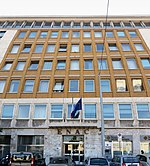The Biblioteca nazionale centrale di Roma (Rome National central Library), in Rome, is one of two central national libraries of Italy, along with Biblioteca Nazionale Centrale di Firenze in Florence. In total, 9 national libraries exist, out of 46 state libraries.The library's mission is to collect and preserve all the publications in Italy and the most important foreign works, especially those related to Italy, and make them available to anyone.
The collection currently includes more than 7,000,000 printed volumes, 2,000 incunabula, 25,000 cinquecentine (16th century books), 8,000 manuscripts, 10,000 drawings, 20,000 maps, and 1,342,154 brochures.As of 1990, the catalog of the library has been online, containing information on all printed documents received to the library since that year as well as important collections obtained over time, all titles of periodical publications, and parts of monographic publications, among other notable archived items.
In order to access the Library, you need a valid Reader’s pass. This is issued by the Ufficio Accoglienza e Relazioni con il pubblico. Please bring a valid ID. Users must leave their bags, food and beverage in the cloakroom. If you need to use your own books, you must get permission from the Ufficio Accoglienza. The Library only allows entry of books not in its catalogues.
The BNCR launched several digitization projects with the purpose of enhancing its own collections and make them available to an increasing number of readers. The documents are available at: digitale.bnc.roma.sbn.it/tecadigitale.
The Library supports cultural promotion and preservation through an extensive programme of events which includes lectures, video projections, concerts, art exhibitions and guided tours. Authors, publishers, bookshops, libraries, cultural associations are all welcome.
There are three public exhibition spaces in the hall of the building. Firstly, Museo Spazi900 dedicated to contemporary italian literature. La stanza di Elsa is at the very heart of the museum. It is here that Elsa Morante’s studio was recreated with its original furniture. Secondly, La grande Biblioteca d’Italia: bibliotecari, architetti e artisti all’opera: 1975-2015 is a permanent exhibition that celebrates the 40th anniversary of BNCR reopening and the 50th anniversary from the start of its construction in Castro Pretorio. Lastly, the third area hosts temporary exhibitions that exhibit the precious resources preserved by the Library.
From July 2021, in the “Biblioteca del Novecento letterario italiano Enrico Falqui” readers can visit the Sala Italo Calvino, where furniture, objects and paintings retrieved from the apartment Calvino lived in at Piazza di Campo Marzio during the latter years of his life.
Guided tours of the library are also available.










